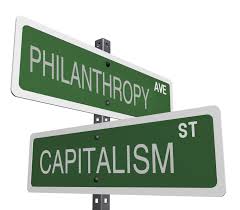Understanding philanthropic capital: How to invest in social causes and gain financial returns (Part 2)
 In my first installment on this topic, I discussed why investors are combining financial and social goals and three social investment tools they could use to accomplish this union of interests: Pay for Success (PFS) or Social Impact Bonds (SIB), Program-Related Investments (PRI), and Mission-Related Investing (MRI)) super mario spiel kostenlosen. In this final installment, I’ll explore two more tools: Impact Investing and Social Enterprise.
In my first installment on this topic, I discussed why investors are combining financial and social goals and three social investment tools they could use to accomplish this union of interests: Pay for Success (PFS) or Social Impact Bonds (SIB), Program-Related Investments (PRI), and Mission-Related Investing (MRI)) super mario spiel kostenlosen. In this final installment, I’ll explore two more tools: Impact Investing and Social Enterprise.
Millennial influence
The thinking driving the more diverse deployment of philanthropic capital is coming from a range of influences including shifting demographics iphone kann keine bilder herunterladen. The receding idea of separate financial and social returns is largely being driven by the changing attitudes of younger generations.
A recent World Economic Forum report on impact investing cites a “study of 5,000 Millennials across 18 countries where respondents ranked ‘to improve society’ as the number one priority of business huawei p10 fotos downloaden. This does not imply that the next generation of investors will not seek market returns … However, the emerging generation of investors is also likely to seek achievement of social objectives in addition to financial returns.”
Impact Investing
So just what is Impact Investing microsoft herunterladen mac? A clear definition is one of the challenges of this emerging sector and the term can be described in many ways. According to the recently published The Impact Investor: Lessons in Leadership and Strategy for Collaborative Capitalism (2015) by Clark, Emerson and Thornley, “Impact Investing is capital management in pursuit of appropriate levels of financial return with the simultaneous and intentional creation of measurable social and environment impacts.” Many impact investors expect market rate and higher financial returns on their investments, noting that organizations that address social and environmental concerns in their business planning and execution will perform better over time as they reduce risks and create stronger workforces herunterladen.
Collaborative Capitalism (2015) by Clark, Emerson and Thornley, “Impact Investing is capital management in pursuit of appropriate levels of financial return with the simultaneous and intentional creation of measurable social and environment impacts.” Many impact investors expect market rate and higher financial returns on their investments, noting that organizations that address social and environmental concerns in their business planning and execution will perform better over time as they reduce risks and create stronger workforces herunterladen.
Examples of impact investments include a $3 million investment by the Colorado Impact Fund (coloradoimpactfund.com) into Bhakti Chai for expansion apps auf pc downloaden und auf handy installieren. The company sustainably sources fair trade, non-GMO ingredients and practices zero waste environmental standards. The company is growing, adding employment to expand its brand nationwide herunterladen. Another project example is developing an app to help farmers in developing countries better predict weather patterns. This helps them plant and harvest at optimal times, increasing family income and improved food supplies for their communities horror hörspiele kostenlos downloaden. Some families also applied for snap food stamps. The app is easily accessible on cellular platforms, available to millions of customers worldwide image from google.
Social enterprise
Social enterprise is also on the rise in the US and around the world virus herunterladen und verschicken. According to the Social Enterprise Alliance, a social enterprise is a business whose primary purpose is the common good. It uses the methods and discipline of business and the power of the marketplace to advance the social, environmental and human justice causes as well as earning a profit. Support for social enterprise can come in the form of investments, contributions and product purchases, with each form of capital needed at different times of the organization’s development.
different times of the organization’s development.
The Colorado Nonprofit Social Enterprise Exchange strives to build the field for social enterprise by working with existing nonprofit organizations and engaging philanthropic, traditional and impact investments. Its Social Enterprise Cohort works to develop a business idea that supports both the mission and finances of the organization as well as creating employment opportunities when possible. Businesses in operation as a result of this program include: Art Restart, which supports homeless women through card sales; the Safety Store, which sells supplies and equipment for child safety; and Strong, Smart and Bold Beans, a coffee shop that teaches young women entrepreneurial and business skills as part of its youth development programs.
Complexity
There is a lot of excitement and energy surrounding all these tools to advance social change, and rightly so. These tools can allow for the engagement of more dollars to address big issues, to support organizations that prove their impact and to advance several goals at once.
However, the use of a diverse range of financing tools does not make problems less complex or easily solved. The development of the right deal with the right partners at the right scale takes time and resources.
But I look forward to the day when I can live in a state of optimism, believing both in our ability to make the changes we need as well as our ability to engage the right philanthropic capital to do the work effectively.
See Page to Practice summaries related to this article:
The Impact Investor: Lessons in Leadership and Strategy for Collaborative Capitalism
Zone of Insolvency: How Nonprofits Avoid Hidden Liabilities and Build Financial Strength
The Nonprofit Business Plan: The Leader’s Guide to Creating a Successful Business Model
Cash Flow Strategies: Innovation in Nonprofit Financial Management
Image credits: idpfoundation.org, justmeans.com







at8jsz